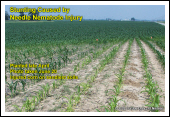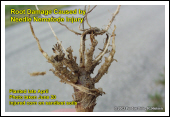Originally published 1995, Updated June 2008
URL: http://www.kingcorn.org/news/timeless/TallShortGreenYellow.html
Tall Corn, Short Corn, Green Corn, Yellow Corn
R.L. (Bob) Nielsen
Agronomy Dept., Purdue Univ.
West Lafayette, IN 47907-2054
Email address: rnielsen
at purdue.edu
![]() omewhere
every year in Indiana there are fields of corn that begin their life uniformly
healthy but then deteriorate into a mottled mess of tall corn, short corn,
green corn, and yellow corn. Sometimes the transformation from uniform to
mottled mess occurs slowly, sometimes it almost seems to occur overnight.
There are several possible stresses that result in tall corn, short corn,
green corn, and yellow corn within a single field. Often it is difficult to
assign blame to a single one of these causes because they often occur together.
omewhere
every year in Indiana there are fields of corn that begin their life uniformly
healthy but then deteriorate into a mottled mess of tall corn, short corn,
green corn, and yellow corn. Sometimes the transformation from uniform to
mottled mess occurs slowly, sometimes it almost seems to occur overnight.
There are several possible stresses that result in tall corn, short corn,
green corn, and yellow corn within a single field. Often it is difficult to
assign blame to a single one of these causes because they often occur together.
Ponded, Saturated Soils
Excessive rainfall is a common occurrence in Indiana early in the growing season and, coupled with inadequate soil drainage, is one of the primary yield limiting factors for corn in the Eastern Corn Belt. Ponded areas within fields or soils that are simply soggy (saturated) for days on end can quickly damage root development and stunt further development of the crop. The stunting and yellowing of the plants is not due initially to nitrogen loss, but rather to the oxygen-depleted status of the soil that limits root functioning and later causes outright death of root tissue (sometimes in concert with soil-borne diseases). When ponding or soggy soils occur near the start of the rapid growth phase (about leaf stage V5 or so), the stunted appearance of the affected plants becomes even more vivid as the non-affected plants "explode" into their rapid growth. Row cultivation or the soil disturbance caused by knifing in sidedress nitrogen fertilizer can help break up dense surface layers in previously ponded areas, resulting in better soil aeration. Improvements in surface drainage or artificial drainage (field tile) can easily pay for themselves in a short period of time in terms of more successful stand establishment and more consistent yields.
Soil Nitrogen Loss
Where excessive rainfall has caused extensive ponding or periods of saturated soils, loss of soil nitrate nitrogen in that anaerobic environment by denitrification can be great. Where soil nitrogen loss has not been significant, plants stunted by the ponding may eventually recover much of their healthy green color. However, if soil nitrogen loss has been severe, the stunted plants will continue to deteriorate and become even more yellow over time.
Soil Compaction
Because of the common occurrence of excessive rainfall early in the season throughout Indiana and our naturally poorly drained soils, soil compaction due to tillage or planting is often pervasive in many fields. In some fields, initial plant development is hindered by furrow sidewall compaction caused by planting in soils that were too wet. As plants near knee-high (V6 or six-leaf collar stage), their root systems extend deep enough to "feel" the restriction caused by tillage and tire traffic compaction. Coupled with either excessively soggy soils or excessively dry soils at this point in time, the consequences of restricted root development due to compaction will quickly become evident as the crop begins its rapid growth phase.
Above-ground symptoms of soil compaction include leaf rolling (dry soils), short plants, and off-color plants. Below-ground symptoms include horizontal root growth, crooked root growth, flattened roots, and more profuse lateral root branching. Herbicide injury is also often accentuated in areas where corn roots are also restricted by soil compaction. Remember that the severity of soil compaction in a field is usually uneven and distinct patterns of symptoms are not always evident.
Row cultivation may break up surface soil layers, but not deeper soil compaction. Soil disturbance caused by knifing in sidedress anhydrous ammonia may help shatter some of the deeper soil compaction if the soils are sufficiently dry.
Herbicide Injury
corn plants.Nematode Injury

![]()

Corn nematodes are often overlooked as a possible cause for stunted, discolored
Related References

